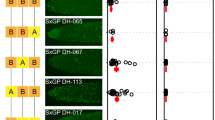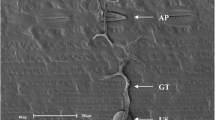Abstract
The Magnaporthe oryzae–M. grisea species complex is composed of several host-specific subgroups, but does not contain a barley-specific subgroup. To characterize the relationship between barley and these subgroups, we inoculated 24 barley cultivars separately with each of 18 isolates from various hosts. The interactions between these cultivars and isolates included various reactions from nonhost-like immune responses to typical host responses. Evenly closely related isolates of the blast fungi caused such contrasting reactions. The immune responses of barley cultivars against a Setaria isolate, Si-1J, were examined in detail. An infection assay with near-isogenic fungal strains suggested that PWT1, which was first identified as a major gene conditioning the avirulence of Si-1J on wheat, was involved in the avirulence on two-thirds of the barley cultivars. At the cytological level, the immune responses were associated with both papilla formation and hypersensitive reaction (HR). Of these two, however, HR played a more critical role than papilla formation. Studying the interactions of barley with M. oryzae and M. grisea may reveal various steps in the process of host specialization of a parasite species and the concomitant evolution of host resistance.





Similar content being viewed by others
References
Chuma I, Zhan SW, Asano S, Nga NTT, Vy TTP, Shirai M, Ibaragi K, Tosa Y (2010) PWT1, an avirulence gene of Magnaporthe oryzae tightly linked to the rDNA locus, is recognized by two staple crops, common wheat and barley. Phytopathology 100:436–443
Couch BC, Kohn LM (2002) A multilocus gene genealogy concordant with host preference indicates segregation of a new species, Magnaporthe oryzae, from M. grisea. Mycologia 94:683–693
Hirata K, Kusaba M, Chuma I, Osue J, Nakayashiki H, Mayama S, Tosa Y (2007) Speciation in Pyricularia inferred from multilocus phylogenetic analysis. Mycol Res 111:799–808
Inukai T, Vales MI, Hori K, Sato K, Hayes PM (2006) RMo1 confers blast resistance in barley and is located within the complex of resistance genes containing Mla, a powdery mildew resistance gene. Mol Plant Microbe Interact 19:1034–1041
Kang S, Sweigard JA, Valent B (1995) The PWL host specificity gene family in the blast fungus Magnaporthe grisea. Mol Plant Microbe Interact 8:939–948
Kato H, Yamamoto M, Yamaguchi-Ozaki T, Kadouchi H, Iwamoto Y, Nakayashiki H, Tosa Y, Mayama S, Mori N (2000) Pathogenicity, mating ability and DNA restriction fragment length polymorphisms of Pyricularia populations isolated from Gramineae, Bambusoideae and Zingiberaceae plants. J Gen Plant Pathol 66:30–47
Murakami J, Tosa Y, Kataoka T, Tomita R, Kawasaki J, Chuma I, Sesumi Y, Kusaba M, Nakayashiki H, Mayama S (2000) Analysis of host species specificity of Magnaporthe grisea toward wheat using a genetic cross between isolates from wheat and foxtail millet. Phytopathology 90:1060–1067
Rustérucci C, Aviv DH, Holt BF, Dangl JL, Parker JE (2001) The disease resistance signaling components EDS1 and PAD4 are essential regulators of the cell death pathway controlled by LSD1 in Arabidopsis. Plant Cell 13:2211–2224
Sweigard JA, Carroll AM, Kang S, Farrall L, Chumley FG, Valent B (1995) Identification, cloning, and characterization of PWL2, a gene for host species specificity in the rice blast fungus. Plant Cell 7:1221–1233
Takabayashi N, Tosa Y, Oh HS, Mayama S (2002) A gene-for-gene relationship underlying the species-specific parasitism of Avena/Triticum isolates of Magnaporthe grisea on wheat cultivars. Phytopathology 92:1182–1188
Taylor JW, Jacobson DJ, Kroken S, Kasuga T, Geiser DM, Hibbett DS, Fisher MC (2000) Phylogenetic species recognition and species concepts in fungi. Fungal Genet Biol 31:21–32
Tosa Y, Hirata K, Tamba H, Nakagawa S, Chuma I, Isobe C, Osue J, Urashima AS, Don LD, Kusaba M, Nakayashiki H, Tanaka A, Tani T, Mori N, Mayama S (2004) Genetic constitution and pathogenicity of Lolium isolates of Magnaporthe oryzae in comparison with host species-specific pathotypes of the blast fungus. Phytopathology 94:454–462
Tosa Y, Tamba H, Tanaka K, Mayama S (2006) Genetic analysis of host species specificity of Magnaporthe oryzae isolates from rice and wheat. Phytopathology 96:480–484
Valent B, Chumley FG (1994) Avirulence genes and mechanisms of genetic instability in the rice blast fungus. In: Zeigler RS, Leong SA, Teng PS (eds) Rice blast disease. CAB International, Wallingford, pp 111–134
Vogel J, Somerville S (2000) Isolation and characterization of powdery mildew-resistant Arabidopsis mutants. Proc Natl Acad Sci USA 97:1897–1902
Yaegashi H (1978) Inheritance of pathogenicity in crosses of Pyricularia isolates from weeping lovegrass and finger millet. Ann Phytopathol Soc Jpn 44:626–632
Yaegashi H (1988) Inheritance of blast resistance in two-rowed barley. Plant Dis 72:608–610
Zellerhoff N, Jarosch B, Groenewald JZ, Crous PW, Schaffrath U (2006) Nonhost resistance of barley is successfully manifested against Magnaporthe grisea and a closely related Pennisetum-infecting lineage but is overcome by Magnaporthe oryzae. Mol Plant Microbe Interact 19:1014–1022
Acknowledgments
We are grateful to U. Hiura, emeritus professor at Okayama University, for providing the barley cultivars and to K. Sato, Okayama University, for critically reading the manuscript. We also thank S. Mayama, emeritus professor at Kobe University, for constant support, encouragements, and suggestions. Special thanks are due to H. Kato, former professor at Kobe University, for providing the isolates, detailed information on them, and valuable suggestions.
Author information
Authors and Affiliations
Corresponding author
Electronic supplementary material
Below is the link to the electronic supplementary material.
Rights and permissions
About this article
Cite this article
Hyon, GS., Nga, N.T.T., Chuma, I. et al. Characterization of interactions between barley and various host-specific subgroups of Magnaporthe oryzae and M. grisea . J Gen Plant Pathol 78, 237–246 (2012). https://doi.org/10.1007/s10327-012-0386-6
Received:
Accepted:
Published:
Issue Date:
DOI: https://doi.org/10.1007/s10327-012-0386-6




